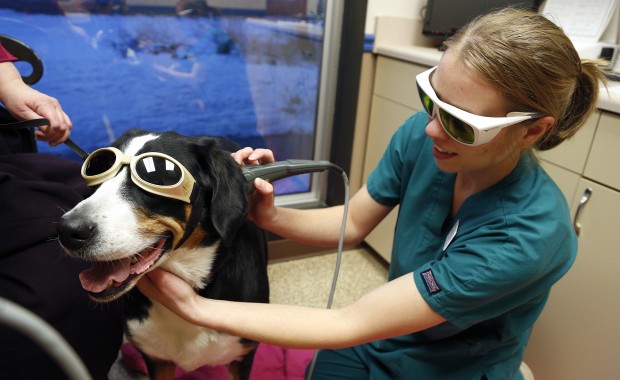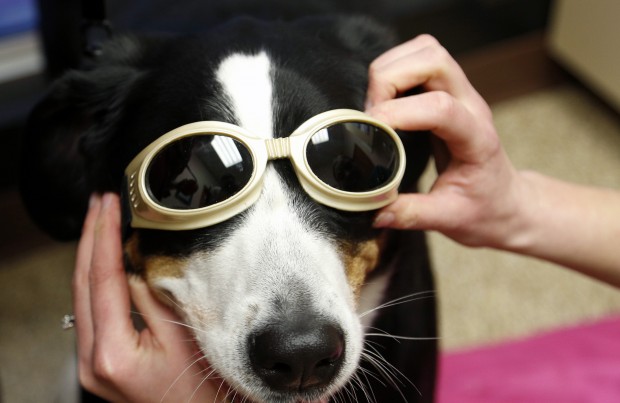Jan. 8, 2013
As Boomer, a 3-year-old Greater Swiss Mountain dog, enters the colorfully painted lobby of Pawsitive Pet Care she is in good spirits, excited even, to be visiting her vet.
Less than two weeks ago, Boomer was having trouble walking. She was uncoordinated and dragging her paws.
Boomer suffers from Wobbler syndrome, a neurologic disease found mostly in large breed dogs that affects their spine in the neck region. The degenerative disease can affect the dog's gait. Animals may have trouble getting up, appear weak and their front paws may buckle under. In some cases, the disease will lead to paralysis.
 In an effort to avoid surgery and decrease the amount of medication the dog takes, owner Kim Stainbrook and veterinarian Bradley Kneeland are pursuing alternative methods of treatment for Boomer.
In an effort to avoid surgery and decrease the amount of medication the dog takes, owner Kim Stainbrook and veterinarian Bradley Kneeland are pursuing alternative methods of treatment for Boomer.
Many patients choose to have their medical issues treated holistically in lieu of, or in conjunction with, conventional methods of treatment, and a growing number of pet owners are making that same choice for their animals.
"Over the last five years, it has really blossomed," Kneeland said of the popularity of alternative medical treatment for pets. "We're doing alternative therapies every day."
Kneeland credits the acceptance of such treatments for human patients as a major reason for the increase in the demand for the same treatments for pets.
"We've seen good results in humans, making them more accepted, and that translates to animals," he said.
Kneeland offers a variety of alternative, or holistic, treatments for his clients' pets, and he is one of only a few doing so in the Cedar Valley.
The services Kneeland offers range from treatments based on ancient techniques, such as acupuncture, to technologically advanced methods like laser therapy.
Acupuncture is used to treat behavior issues, musculoskeletal problems, soft tissue issues, even allergies, Kneeland said.
Laser therapy also is used to treat soft tissue issues as well as swelling, post-surgery inflammation and pain.
Kneeland also offers chiropractic services to address head, neck and back problems and pinched nerves, herniated discs and skeletal issues. There's also herbal treatments, which can reduce the need for drugs and help to improve an animal's behavior, among other things.
Kneeland, who obtained his degree from Iowa State University College of Veterinary Medicine in 1993, said there were no courses offered in alternative medicine when he was in school.
"Now some colleges offer alternative veterinary rotations," he said.
Kneeland received his training in alternative methods through courses he has taken and training offered by equipment manufacturers, he said.
"They show us how to use it, what to use it for," he said of the laser therapy equipment he uses. "This is the same unit used by professional football teams."
Boomer is taken to a treatment room where registered technician Katie Sebetka administers laser blasts to certain points around the dog's neck. Boomer stands calmly throughout the 10-minute procedure, wearing "doggles" to protect her eyes. This is her sixth treatment.
Not everyone is ready to accept alternative methods of treatment, Kneeland said.
"You have some people who are hesitant," he said. "You have the outliers on both sides," he said. "Some want only conventional and no alternative, and others want only alternative and no conventional.
"But I'm seeing less and less who only want conventional," he said. "I can't remember the last person who turned down holistic treatment. Most are willing to marry alternative and conventional treatments and enjoy the synergistic effects."
In the long run, the costs of alternative and conventional treatments are comparable, he said.
Kneeland said alternative treatments work better on some animals than others.
"It's not perfect," he said. "If a disease has progressed so far, all we can do is palliative care, make the animal feel better."
For Boomer, laser therapy has considerably improved her condition.
"She was running around and playing after the first week of treatment," Kneeland said.
In this article we are told, therefore, the efficiency that these procedures, which most of us may never have raised or their existence. It's really when you have a problem like this, or better said, a sick pet to which you want as a member of the family, when one reconsiders the use of these treatments, because if it agrees to perform them on one same, why not on an animal that is part of your heart and you want to cure every possible way?
"I could see a difference after two treatments, and she's gotten better since," said Stainbrook. "She's much more playful. It's like having my dog back."
COMENT
We find ourselves before an article published in WCF COURIER's web page on 12th January 2013 that is about the alternative medicine treatments performed in pets.
Veterinary medicine is applying alternative methods of diagnosis and cure of diseases.
 It's pure logic to realize that if these treatments work in people may also may be useful in animals, so this initiative is becoming very popular in many places. These types of treatments that help both people and animals are increasing their demand due to many advances in alternative sciences (although they are closely related to medicine convencioanal have been detached much in recent years).
It's pure logic to realize that if these treatments work in people may also may be useful in animals, so this initiative is becoming very popular in many places. These types of treatments that help both people and animals are increasing their demand due to many advances in alternative sciences (although they are closely related to medicine convencioanal have been detached much in recent years).
Although this may also be the reason that many still do not dare to use innovative techniques on their pets. There are opinions for all tastes. here is no medicine better than others, just each has a different way of diagnosis and treatment. Each medicine sees disease, diagnosis and healing from a different angle. Although it is true that depending on the different cases of problems and pets, there are more or less complicated solutions and effective.
This helps us understand who each have their advantages and limitations. We conclude that each time we decide what is best for our animal, a drug or another or a combination of several.
No hay comentarios:
Publicar un comentario